UGB161 Introduction to Marketing: Marks and Spencer Analysis Report
VerifiedAdded on 2023/04/22
|21
|4314
|91
Report
AI Summary
This report provides a comprehensive marketing analysis of Marks & Spencer (M&S), evaluating its current business performance, marketing strategies, and market position. It delves into the company's digital marketing efforts, pricing strategies, and diversified product ranges. The report assesses M&S's market position using the Boston Consulting Group matrix, analyzes its competitors, and examines market segmentation strategies, including behavioral and demographic approaches. Furthermore, it proposes strategies for increasing brand awareness and market share, incorporates SWOT and PESTLE analyses, and concludes with recommendations for future marketing initiatives. The analysis highlights key areas for improvement and growth within the competitive retail landscape, emphasizing the importance of understanding customer needs and adapting marketing strategies to changing market dynamics.

Marks and Spencer 0
Marks and Spencer
Marketing analysis
Student’s Name
4/5/2019
Marks and Spencer
Marketing analysis
Student’s Name
4/5/2019
Paraphrase This Document
Need a fresh take? Get an instant paraphrase of this document with our AI Paraphraser
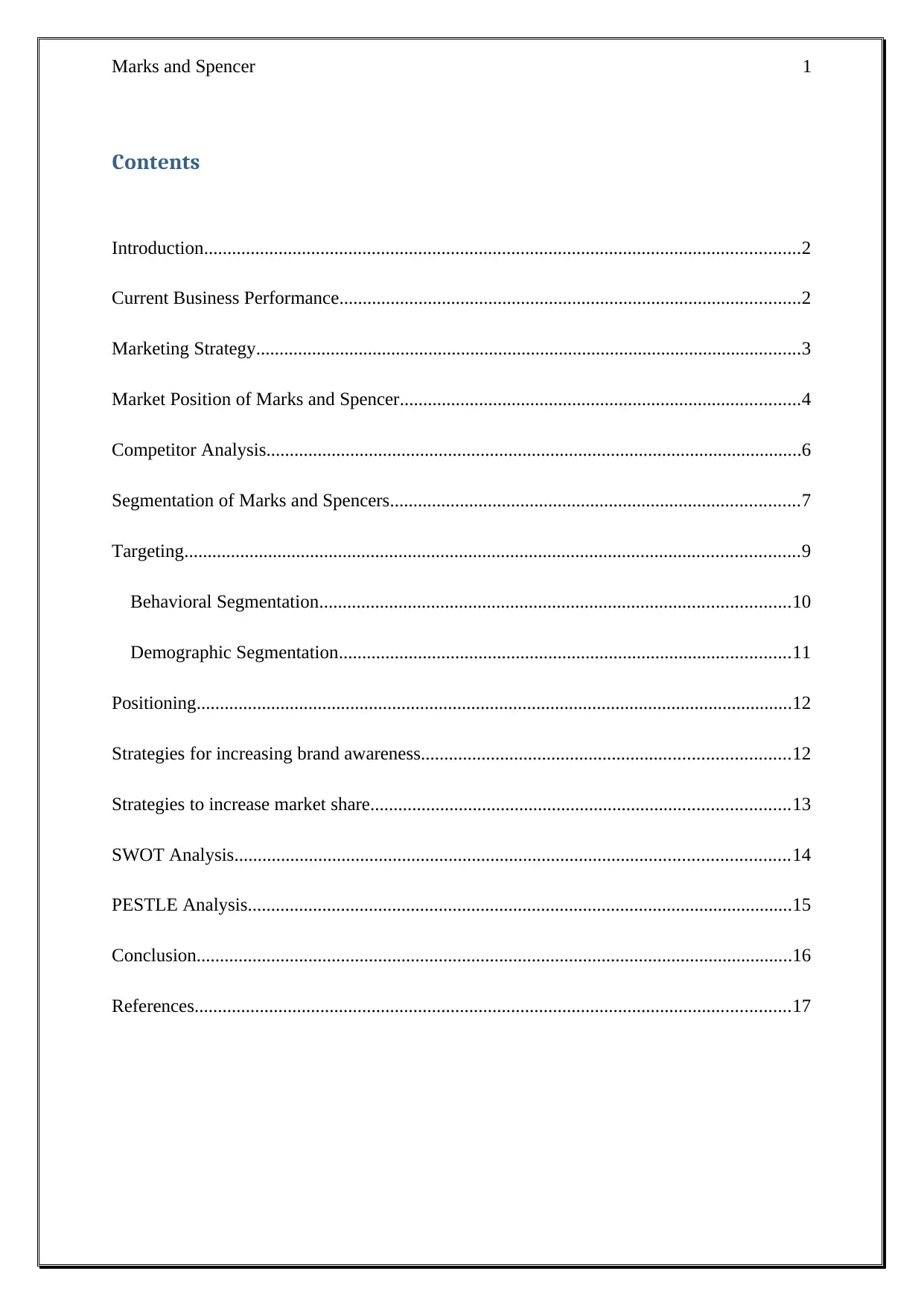
Marks and Spencer 1
Contents
Introduction................................................................................................................................2
Current Business Performance...................................................................................................2
Marketing Strategy.....................................................................................................................3
Market Position of Marks and Spencer......................................................................................4
Competitor Analysis...................................................................................................................6
Segmentation of Marks and Spencers........................................................................................7
Targeting....................................................................................................................................9
Behavioral Segmentation.....................................................................................................10
Demographic Segmentation.................................................................................................11
Positioning................................................................................................................................12
Strategies for increasing brand awareness...............................................................................12
Strategies to increase market share..........................................................................................13
SWOT Analysis.......................................................................................................................14
PESTLE Analysis.....................................................................................................................15
Conclusion................................................................................................................................16
References................................................................................................................................17
Contents
Introduction................................................................................................................................2
Current Business Performance...................................................................................................2
Marketing Strategy.....................................................................................................................3
Market Position of Marks and Spencer......................................................................................4
Competitor Analysis...................................................................................................................6
Segmentation of Marks and Spencers........................................................................................7
Targeting....................................................................................................................................9
Behavioral Segmentation.....................................................................................................10
Demographic Segmentation.................................................................................................11
Positioning................................................................................................................................12
Strategies for increasing brand awareness...............................................................................12
Strategies to increase market share..........................................................................................13
SWOT Analysis.......................................................................................................................14
PESTLE Analysis.....................................................................................................................15
Conclusion................................................................................................................................16
References................................................................................................................................17
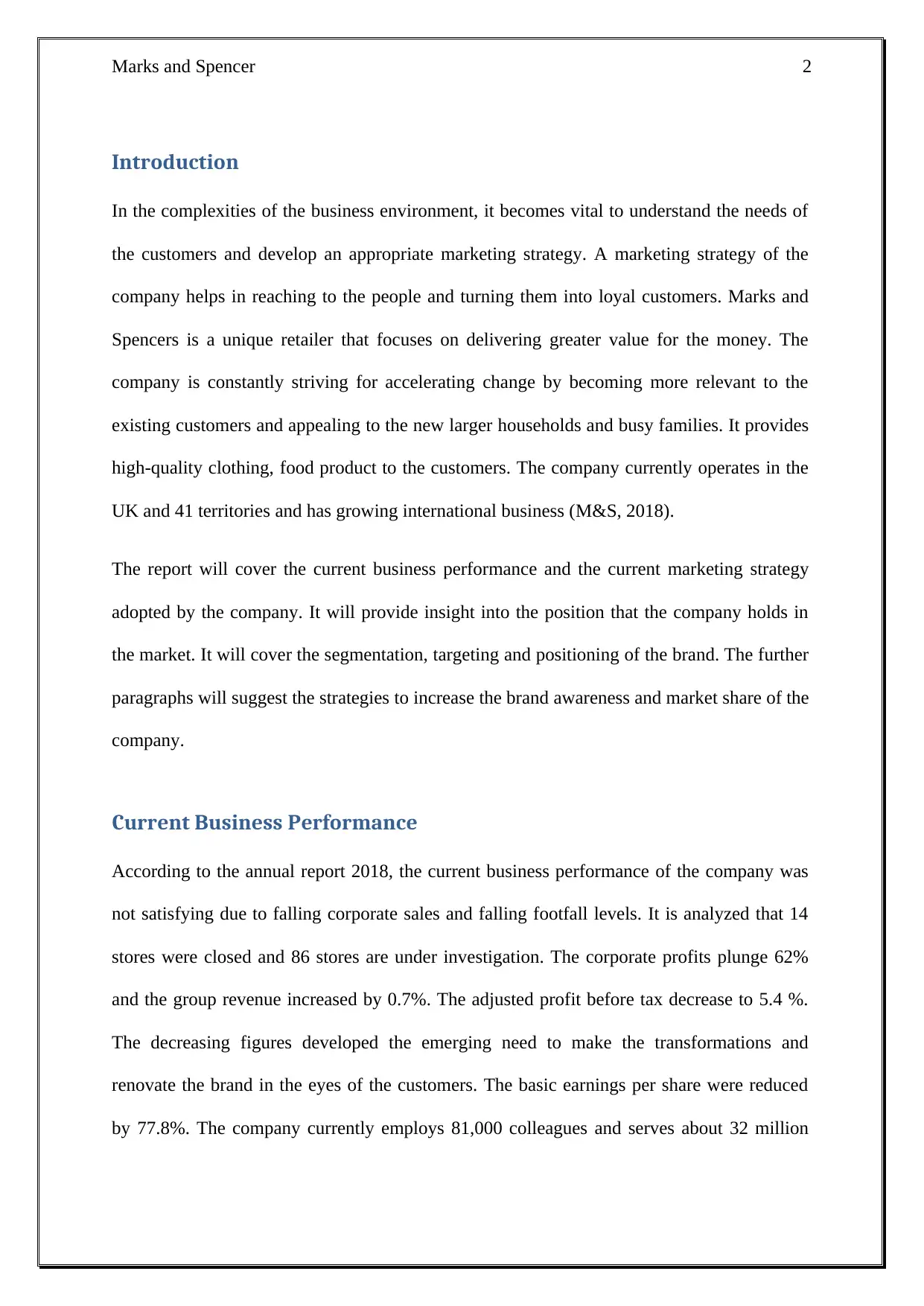
Marks and Spencer 2
Introduction
In the complexities of the business environment, it becomes vital to understand the needs of
the customers and develop an appropriate marketing strategy. A marketing strategy of the
company helps in reaching to the people and turning them into loyal customers. Marks and
Spencers is a unique retailer that focuses on delivering greater value for the money. The
company is constantly striving for accelerating change by becoming more relevant to the
existing customers and appealing to the new larger households and busy families. It provides
high-quality clothing, food product to the customers. The company currently operates in the
UK and 41 territories and has growing international business (M&S, 2018).
The report will cover the current business performance and the current marketing strategy
adopted by the company. It will provide insight into the position that the company holds in
the market. It will cover the segmentation, targeting and positioning of the brand. The further
paragraphs will suggest the strategies to increase the brand awareness and market share of the
company.
Current Business Performance
According to the annual report 2018, the current business performance of the company was
not satisfying due to falling corporate sales and falling footfall levels. It is analyzed that 14
stores were closed and 86 stores are under investigation. The corporate profits plunge 62%
and the group revenue increased by 0.7%. The adjusted profit before tax decrease to 5.4 %.
The decreasing figures developed the emerging need to make the transformations and
renovate the brand in the eyes of the customers. The basic earnings per share were reduced
by 77.8%. The company currently employs 81,000 colleagues and serves about 32 million
Introduction
In the complexities of the business environment, it becomes vital to understand the needs of
the customers and develop an appropriate marketing strategy. A marketing strategy of the
company helps in reaching to the people and turning them into loyal customers. Marks and
Spencers is a unique retailer that focuses on delivering greater value for the money. The
company is constantly striving for accelerating change by becoming more relevant to the
existing customers and appealing to the new larger households and busy families. It provides
high-quality clothing, food product to the customers. The company currently operates in the
UK and 41 territories and has growing international business (M&S, 2018).
The report will cover the current business performance and the current marketing strategy
adopted by the company. It will provide insight into the position that the company holds in
the market. It will cover the segmentation, targeting and positioning of the brand. The further
paragraphs will suggest the strategies to increase the brand awareness and market share of the
company.
Current Business Performance
According to the annual report 2018, the current business performance of the company was
not satisfying due to falling corporate sales and falling footfall levels. It is analyzed that 14
stores were closed and 86 stores are under investigation. The corporate profits plunge 62%
and the group revenue increased by 0.7%. The adjusted profit before tax decrease to 5.4 %.
The decreasing figures developed the emerging need to make the transformations and
renovate the brand in the eyes of the customers. The basic earnings per share were reduced
by 77.8%. The company currently employs 81,000 colleagues and serves about 32 million
⊘ This is a preview!⊘
Do you want full access?
Subscribe today to unlock all pages.

Trusted by 1+ million students worldwide
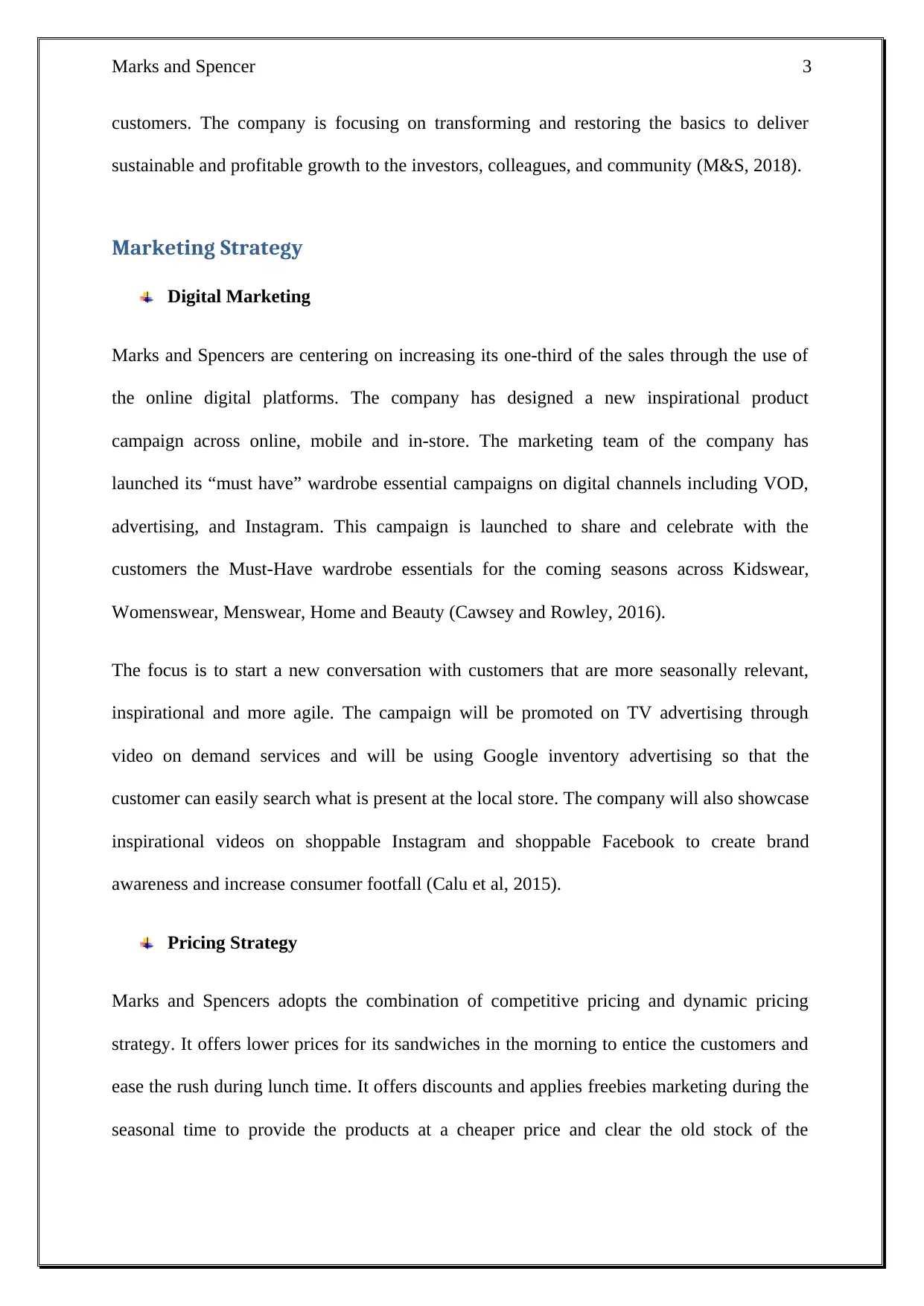
Marks and Spencer 3
customers. The company is focusing on transforming and restoring the basics to deliver
sustainable and profitable growth to the investors, colleagues, and community (M&S, 2018).
Marketing Strategy
Digital Marketing
Marks and Spencers are centering on increasing its one-third of the sales through the use of
the online digital platforms. The company has designed a new inspirational product
campaign across online, mobile and in-store. The marketing team of the company has
launched its “must have” wardrobe essential campaigns on digital channels including VOD,
advertising, and Instagram. This campaign is launched to share and celebrate with the
customers the Must-Have wardrobe essentials for the coming seasons across Kidswear,
Womenswear, Menswear, Home and Beauty (Cawsey and Rowley, 2016).
The focus is to start a new conversation with customers that are more seasonally relevant,
inspirational and more agile. The campaign will be promoted on TV advertising through
video on demand services and will be using Google inventory advertising so that the
customer can easily search what is present at the local store. The company will also showcase
inspirational videos on shoppable Instagram and shoppable Facebook to create brand
awareness and increase consumer footfall (Calu et al, 2015).
Pricing Strategy
Marks and Spencers adopts the combination of competitive pricing and dynamic pricing
strategy. It offers lower prices for its sandwiches in the morning to entice the customers and
ease the rush during lunch time. It offers discounts and applies freebies marketing during the
seasonal time to provide the products at a cheaper price and clear the old stock of the
customers. The company is focusing on transforming and restoring the basics to deliver
sustainable and profitable growth to the investors, colleagues, and community (M&S, 2018).
Marketing Strategy
Digital Marketing
Marks and Spencers are centering on increasing its one-third of the sales through the use of
the online digital platforms. The company has designed a new inspirational product
campaign across online, mobile and in-store. The marketing team of the company has
launched its “must have” wardrobe essential campaigns on digital channels including VOD,
advertising, and Instagram. This campaign is launched to share and celebrate with the
customers the Must-Have wardrobe essentials for the coming seasons across Kidswear,
Womenswear, Menswear, Home and Beauty (Cawsey and Rowley, 2016).
The focus is to start a new conversation with customers that are more seasonally relevant,
inspirational and more agile. The campaign will be promoted on TV advertising through
video on demand services and will be using Google inventory advertising so that the
customer can easily search what is present at the local store. The company will also showcase
inspirational videos on shoppable Instagram and shoppable Facebook to create brand
awareness and increase consumer footfall (Calu et al, 2015).
Pricing Strategy
Marks and Spencers adopts the combination of competitive pricing and dynamic pricing
strategy. It offers lower prices for its sandwiches in the morning to entice the customers and
ease the rush during lunch time. It offers discounts and applies freebies marketing during the
seasonal time to provide the products at a cheaper price and clear the old stock of the
Paraphrase This Document
Need a fresh take? Get an instant paraphrase of this document with our AI Paraphraser
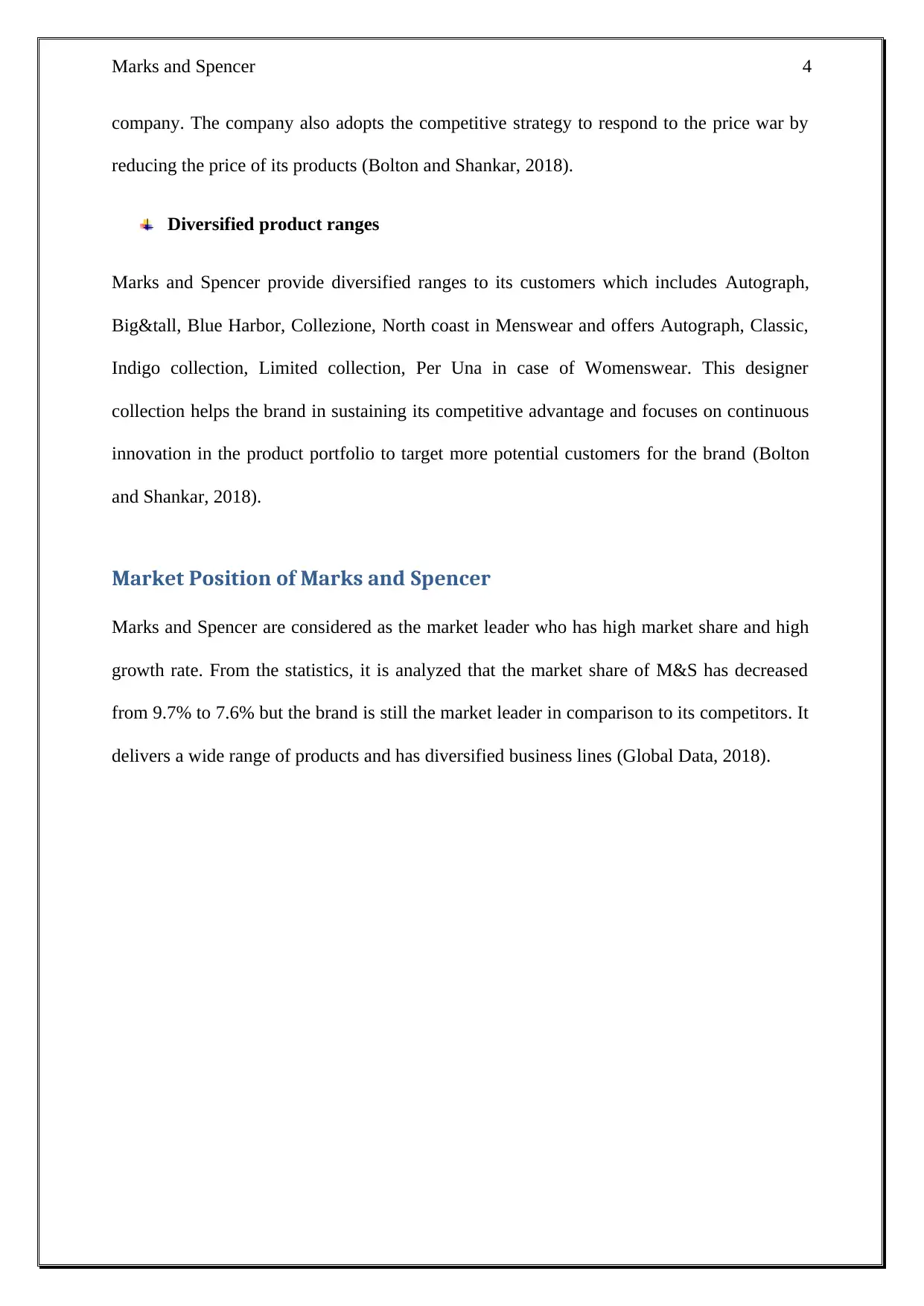
Marks and Spencer 4
company. The company also adopts the competitive strategy to respond to the price war by
reducing the price of its products (Bolton and Shankar, 2018).
Diversified product ranges
Marks and Spencer provide diversified ranges to its customers which includes Autograph,
Big&tall, Blue Harbor, Collezione, North coast in Menswear and offers Autograph, Classic,
Indigo collection, Limited collection, Per Una in case of Womenswear. This designer
collection helps the brand in sustaining its competitive advantage and focuses on continuous
innovation in the product portfolio to target more potential customers for the brand (Bolton
and Shankar, 2018).
Market Position of Marks and Spencer
Marks and Spencer are considered as the market leader who has high market share and high
growth rate. From the statistics, it is analyzed that the market share of M&S has decreased
from 9.7% to 7.6% but the brand is still the market leader in comparison to its competitors. It
delivers a wide range of products and has diversified business lines (Global Data, 2018).
company. The company also adopts the competitive strategy to respond to the price war by
reducing the price of its products (Bolton and Shankar, 2018).
Diversified product ranges
Marks and Spencer provide diversified ranges to its customers which includes Autograph,
Big&tall, Blue Harbor, Collezione, North coast in Menswear and offers Autograph, Classic,
Indigo collection, Limited collection, Per Una in case of Womenswear. This designer
collection helps the brand in sustaining its competitive advantage and focuses on continuous
innovation in the product portfolio to target more potential customers for the brand (Bolton
and Shankar, 2018).
Market Position of Marks and Spencer
Marks and Spencer are considered as the market leader who has high market share and high
growth rate. From the statistics, it is analyzed that the market share of M&S has decreased
from 9.7% to 7.6% but the brand is still the market leader in comparison to its competitors. It
delivers a wide range of products and has diversified business lines (Global Data, 2018).

Marks and Spencer 5
(Global Data, 2018)
The market position of the brand is reflected through Boston Consulting Group
growth/share matrix which will reflect the attractiveness of the brand’s products against
market growth rate and relative market share. The diversified portfolio of the brand is
categorized under four categories i.e. Stars, Question marks, Cash cows and Dogs
Stars are the business units that have high market share and high growth rate. It requires a
huge investment to sustain them. Marks and Spencer are categories as Stars which reflects
high market share and high growth rate of the brand. To expand the market share and growth
rate of the brand it demands huge investment. The new M&S.com website propelled in 2013
reinforced by the new e-commerce distribution center at Castle Donington capable of
(Global Data, 2018)
The market position of the brand is reflected through Boston Consulting Group
growth/share matrix which will reflect the attractiveness of the brand’s products against
market growth rate and relative market share. The diversified portfolio of the brand is
categorized under four categories i.e. Stars, Question marks, Cash cows and Dogs
Stars are the business units that have high market share and high growth rate. It requires a
huge investment to sustain them. Marks and Spencer are categories as Stars which reflects
high market share and high growth rate of the brand. To expand the market share and growth
rate of the brand it demands huge investment. The new M&S.com website propelled in 2013
reinforced by the new e-commerce distribution center at Castle Donington capable of
⊘ This is a preview!⊘
Do you want full access?
Subscribe today to unlock all pages.

Trusted by 1+ million students worldwide
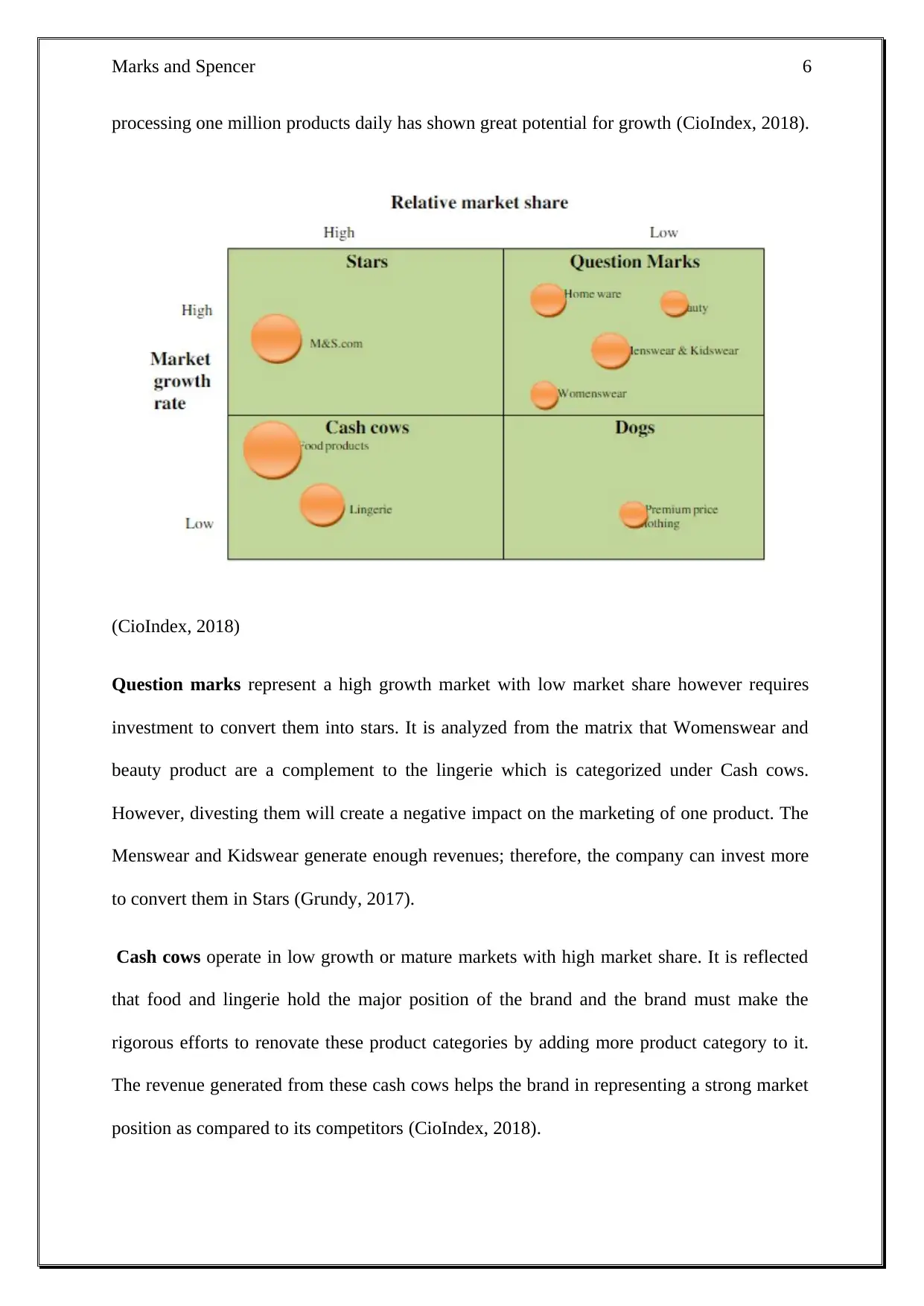
Marks and Spencer 6
processing one million products daily has shown great potential for growth (CioIndex, 2018).
(CioIndex, 2018)
Question marks represent a high growth market with low market share however requires
investment to convert them into stars. It is analyzed from the matrix that Womenswear and
beauty product are a complement to the lingerie which is categorized under Cash cows.
However, divesting them will create a negative impact on the marketing of one product. The
Menswear and Kidswear generate enough revenues; therefore, the company can invest more
to convert them in Stars (Grundy, 2017).
Cash cows operate in low growth or mature markets with high market share. It is reflected
that food and lingerie hold the major position of the brand and the brand must make the
rigorous efforts to renovate these product categories by adding more product category to it.
The revenue generated from these cash cows helps the brand in representing a strong market
position as compared to its competitors (CioIndex, 2018).
processing one million products daily has shown great potential for growth (CioIndex, 2018).
(CioIndex, 2018)
Question marks represent a high growth market with low market share however requires
investment to convert them into stars. It is analyzed from the matrix that Womenswear and
beauty product are a complement to the lingerie which is categorized under Cash cows.
However, divesting them will create a negative impact on the marketing of one product. The
Menswear and Kidswear generate enough revenues; therefore, the company can invest more
to convert them in Stars (Grundy, 2017).
Cash cows operate in low growth or mature markets with high market share. It is reflected
that food and lingerie hold the major position of the brand and the brand must make the
rigorous efforts to renovate these product categories by adding more product category to it.
The revenue generated from these cash cows helps the brand in representing a strong market
position as compared to its competitors (CioIndex, 2018).
Paraphrase This Document
Need a fresh take? Get an instant paraphrase of this document with our AI Paraphraser
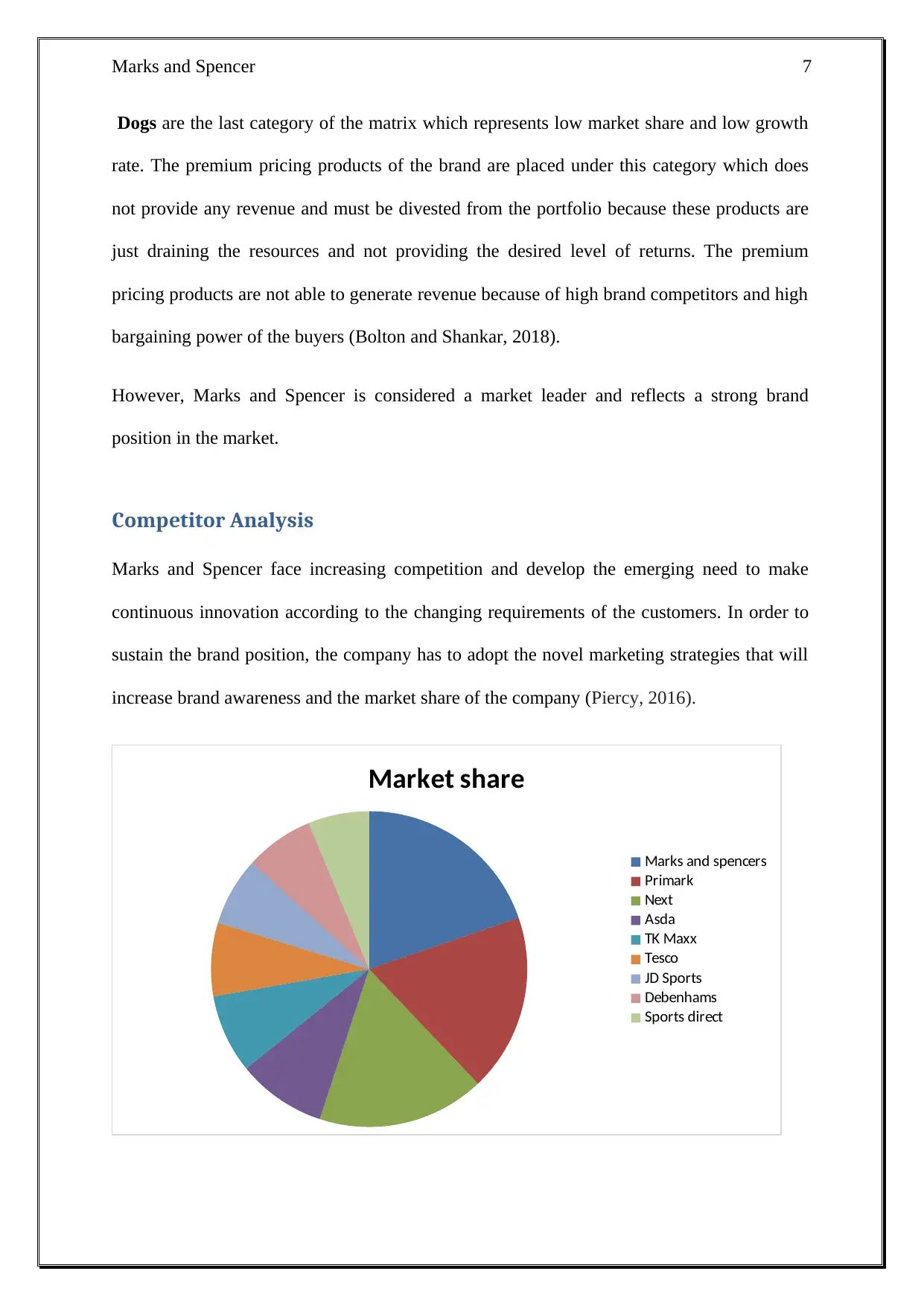
Marks and Spencer 7
Dogs are the last category of the matrix which represents low market share and low growth
rate. The premium pricing products of the brand are placed under this category which does
not provide any revenue and must be divested from the portfolio because these products are
just draining the resources and not providing the desired level of returns. The premium
pricing products are not able to generate revenue because of high brand competitors and high
bargaining power of the buyers (Bolton and Shankar, 2018).
However, Marks and Spencer is considered a market leader and reflects a strong brand
position in the market.
Competitor Analysis
Marks and Spencer face increasing competition and develop the emerging need to make
continuous innovation according to the changing requirements of the customers. In order to
sustain the brand position, the company has to adopt the novel marketing strategies that will
increase brand awareness and the market share of the company (Piercy, 2016).
Market share
Marks and spencers
Primark
Next
Asda
TK Maxx
Tesco
JD Sports
Debenhams
Sports direct
Dogs are the last category of the matrix which represents low market share and low growth
rate. The premium pricing products of the brand are placed under this category which does
not provide any revenue and must be divested from the portfolio because these products are
just draining the resources and not providing the desired level of returns. The premium
pricing products are not able to generate revenue because of high brand competitors and high
bargaining power of the buyers (Bolton and Shankar, 2018).
However, Marks and Spencer is considered a market leader and reflects a strong brand
position in the market.
Competitor Analysis
Marks and Spencer face increasing competition and develop the emerging need to make
continuous innovation according to the changing requirements of the customers. In order to
sustain the brand position, the company has to adopt the novel marketing strategies that will
increase brand awareness and the market share of the company (Piercy, 2016).
Market share
Marks and spencers
Primark
Next
Asda
TK Maxx
Tesco
JD Sports
Debenhams
Sports direct
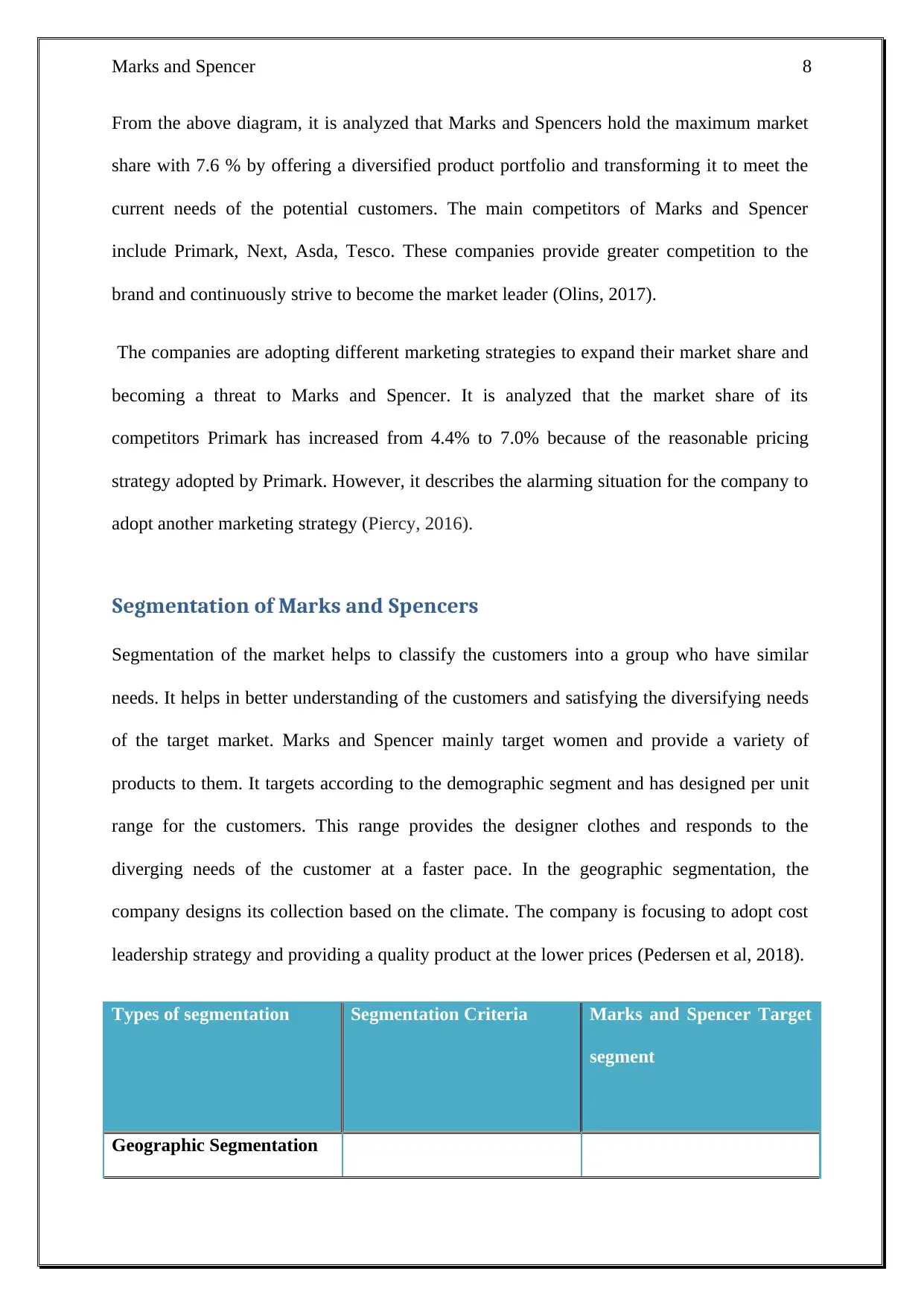
Marks and Spencer 8
From the above diagram, it is analyzed that Marks and Spencers hold the maximum market
share with 7.6 % by offering a diversified product portfolio and transforming it to meet the
current needs of the potential customers. The main competitors of Marks and Spencer
include Primark, Next, Asda, Tesco. These companies provide greater competition to the
brand and continuously strive to become the market leader (Olins, 2017).
The companies are adopting different marketing strategies to expand their market share and
becoming a threat to Marks and Spencer. It is analyzed that the market share of its
competitors Primark has increased from 4.4% to 7.0% because of the reasonable pricing
strategy adopted by Primark. However, it describes the alarming situation for the company to
adopt another marketing strategy (Piercy, 2016).
Segmentation of Marks and Spencers
Segmentation of the market helps to classify the customers into a group who have similar
needs. It helps in better understanding of the customers and satisfying the diversifying needs
of the target market. Marks and Spencer mainly target women and provide a variety of
products to them. It targets according to the demographic segment and has designed per unit
range for the customers. This range provides the designer clothes and responds to the
diverging needs of the customer at a faster pace. In the geographic segmentation, the
company designs its collection based on the climate. The company is focusing to adopt cost
leadership strategy and providing a quality product at the lower prices (Pedersen et al, 2018).
Types of segmentation Segmentation Criteria Marks and Spencer Target
segment
Geographic Segmentation
From the above diagram, it is analyzed that Marks and Spencers hold the maximum market
share with 7.6 % by offering a diversified product portfolio and transforming it to meet the
current needs of the potential customers. The main competitors of Marks and Spencer
include Primark, Next, Asda, Tesco. These companies provide greater competition to the
brand and continuously strive to become the market leader (Olins, 2017).
The companies are adopting different marketing strategies to expand their market share and
becoming a threat to Marks and Spencer. It is analyzed that the market share of its
competitors Primark has increased from 4.4% to 7.0% because of the reasonable pricing
strategy adopted by Primark. However, it describes the alarming situation for the company to
adopt another marketing strategy (Piercy, 2016).
Segmentation of Marks and Spencers
Segmentation of the market helps to classify the customers into a group who have similar
needs. It helps in better understanding of the customers and satisfying the diversifying needs
of the target market. Marks and Spencer mainly target women and provide a variety of
products to them. It targets according to the demographic segment and has designed per unit
range for the customers. This range provides the designer clothes and responds to the
diverging needs of the customer at a faster pace. In the geographic segmentation, the
company designs its collection based on the climate. The company is focusing to adopt cost
leadership strategy and providing a quality product at the lower prices (Pedersen et al, 2018).
Types of segmentation Segmentation Criteria Marks and Spencer Target
segment
Geographic Segmentation
⊘ This is a preview!⊘
Do you want full access?
Subscribe today to unlock all pages.

Trusted by 1+ million students worldwide

Marks and Spencer 9
Region
Density
Climate
Domestic/International
Urban population
Rainfall, humidity, and wind
Demographic Segmentation
Age
Gender
Life cycle stage
Income
Occupation
6-45
Male/Female
The company mainly targets
the teenage age, children, and
older age group.
Middle and higher income
groups.
Students, employees,
professionals, role models.
Behavioral Segmentation
Degree of loyalty Hard core loyal and
switchers
Region
Density
Climate
Domestic/International
Urban population
Rainfall, humidity, and wind
Demographic Segmentation
Age
Gender
Life cycle stage
Income
Occupation
6-45
Male/Female
The company mainly targets
the teenage age, children, and
older age group.
Middle and higher income
groups.
Students, employees,
professionals, role models.
Behavioral Segmentation
Degree of loyalty Hard core loyal and
switchers
Paraphrase This Document
Need a fresh take? Get an instant paraphrase of this document with our AI Paraphraser
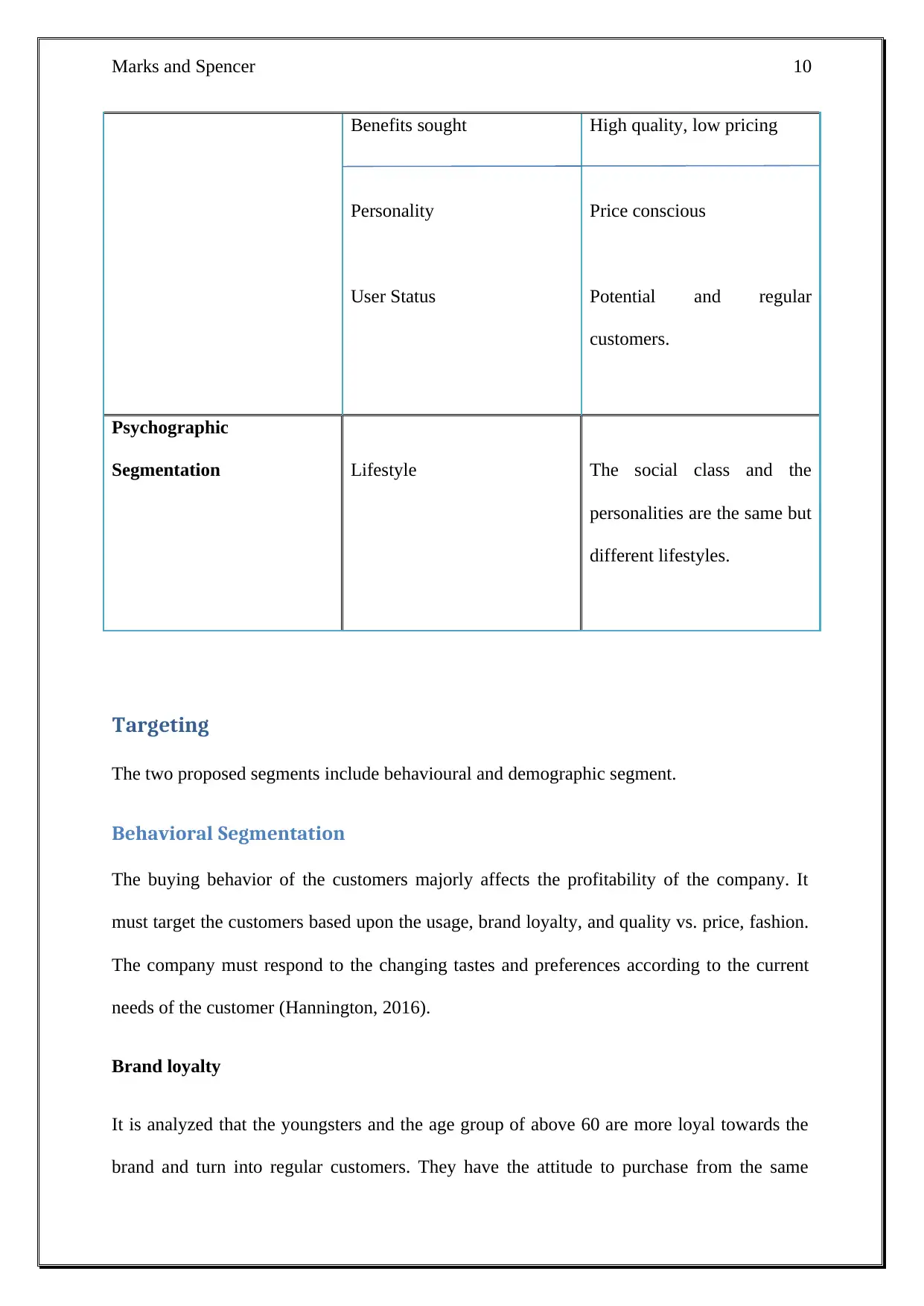
Marks and Spencer 10
Benefits sought
Personality
User Status
High quality, low pricing
Price conscious
Potential and regular
customers.
Psychographic
Segmentation Lifestyle The social class and the
personalities are the same but
different lifestyles.
Targeting
The two proposed segments include behavioural and demographic segment.
Behavioral Segmentation
The buying behavior of the customers majorly affects the profitability of the company. It
must target the customers based upon the usage, brand loyalty, and quality vs. price, fashion.
The company must respond to the changing tastes and preferences according to the current
needs of the customer (Hannington, 2016).
Brand loyalty
It is analyzed that the youngsters and the age group of above 60 are more loyal towards the
brand and turn into regular customers. They have the attitude to purchase from the same
Benefits sought
Personality
User Status
High quality, low pricing
Price conscious
Potential and regular
customers.
Psychographic
Segmentation Lifestyle The social class and the
personalities are the same but
different lifestyles.
Targeting
The two proposed segments include behavioural and demographic segment.
Behavioral Segmentation
The buying behavior of the customers majorly affects the profitability of the company. It
must target the customers based upon the usage, brand loyalty, and quality vs. price, fashion.
The company must respond to the changing tastes and preferences according to the current
needs of the customer (Hannington, 2016).
Brand loyalty
It is analyzed that the youngsters and the age group of above 60 are more loyal towards the
brand and turn into regular customers. They have the attitude to purchase from the same

Marks and Spencer 11
retailer however the company must target the youngsters and the older age group to increase
the market share from loyal customers (Hanssens and Pauwels, 2016).
Fashion
It is evaluated that the youngsters and the age group between 20-45 demands for the latest
designer clothes and are fashion-savvy. The desire for fashion gets decreased from the age of
above 45 however the companies must focus on targeting the younger generation and
responding by developing the latest designer clothes. It is scrutinized that 50% of the
population who are under 35 year age get highly influenced by the latest market trends and
demands for fashionable products (Atulkar and Kesari, 2016).
Price vs. Quality
The preferences of the customers vary from price conscious or quality conscious. It is
analyzed that the youngsters from the age 16-24 are price conscious and some customers
focus on quality rather than the price of the product. However, the consumers who are the
regular customers of Jon Lewis, Debenhams, and Zara prefer quality and the customers who
shops from Primark are price conscious (Hanssens and Pauwels, 2016).
From the above, it is analyzed that in order to target the younger generation the company
must adopt a low-cost pricing strategy and must bring the latest fashions at a fast pace. It
must focus on both the quality and price of the product to increase customer footfall.
Demographic Segmentation
The demographic segmentation is done based upon the age, income, occupation and the life
cycle stage. It will help in getting a deep insight into the customers and expand the market
share of the company.
Age
retailer however the company must target the youngsters and the older age group to increase
the market share from loyal customers (Hanssens and Pauwels, 2016).
Fashion
It is evaluated that the youngsters and the age group between 20-45 demands for the latest
designer clothes and are fashion-savvy. The desire for fashion gets decreased from the age of
above 45 however the companies must focus on targeting the younger generation and
responding by developing the latest designer clothes. It is scrutinized that 50% of the
population who are under 35 year age get highly influenced by the latest market trends and
demands for fashionable products (Atulkar and Kesari, 2016).
Price vs. Quality
The preferences of the customers vary from price conscious or quality conscious. It is
analyzed that the youngsters from the age 16-24 are price conscious and some customers
focus on quality rather than the price of the product. However, the consumers who are the
regular customers of Jon Lewis, Debenhams, and Zara prefer quality and the customers who
shops from Primark are price conscious (Hanssens and Pauwels, 2016).
From the above, it is analyzed that in order to target the younger generation the company
must adopt a low-cost pricing strategy and must bring the latest fashions at a fast pace. It
must focus on both the quality and price of the product to increase customer footfall.
Demographic Segmentation
The demographic segmentation is done based upon the age, income, occupation and the life
cycle stage. It will help in getting a deep insight into the customers and expand the market
share of the company.
Age
⊘ This is a preview!⊘
Do you want full access?
Subscribe today to unlock all pages.

Trusted by 1+ million students worldwide
1 out of 21
Related Documents
Your All-in-One AI-Powered Toolkit for Academic Success.
+13062052269
info@desklib.com
Available 24*7 on WhatsApp / Email
![[object Object]](/_next/static/media/star-bottom.7253800d.svg)
Unlock your academic potential
Copyright © 2020–2025 A2Z Services. All Rights Reserved. Developed and managed by ZUCOL.



